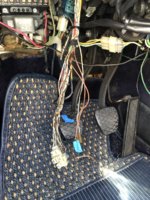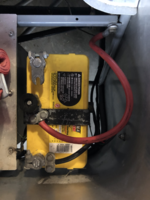A few of months ago I had an electrical short on the headlight switch / wiring under the dash on my 1970 2800cs. Car filled with smoke, I managed to pull off the road and by feel isolated the short. The spot that is hottest is the most is likely the compromised area was my assumption! Worked...but my fingers took a while to heal.
What I am left with is melted wiring on this portion of the harness and the headlight switch pin connector. Photo attached.
I'm seeing a couple of options:
Purchase a replacement partial harness either new (if available?) or used and replace all.
Not my preferred direction, however, as I think it is too invasive for the amount of damage. The damaged area is limited to the wires coming off the switch connector for a distance of about 1 ft. If I can find a partial harness I would rather splice in this section of the wiring into my existing harness.
Are there suggestions as too where I can locate a partial harness? Preferably used but new if necessary. And for this limited portion of the harness could it be from an E3 as well? Gotta think the switch is identical and likely the wiring?
Advice would be greatly appreciated!
John

What I am left with is melted wiring on this portion of the harness and the headlight switch pin connector. Photo attached.
I'm seeing a couple of options:
Purchase a replacement partial harness either new (if available?) or used and replace all.
Not my preferred direction, however, as I think it is too invasive for the amount of damage. The damaged area is limited to the wires coming off the switch connector for a distance of about 1 ft. If I can find a partial harness I would rather splice in this section of the wiring into my existing harness.
Are there suggestions as too where I can locate a partial harness? Preferably used but new if necessary. And for this limited portion of the harness could it be from an E3 as well? Gotta think the switch is identical and likely the wiring?
Advice would be greatly appreciated!
John


